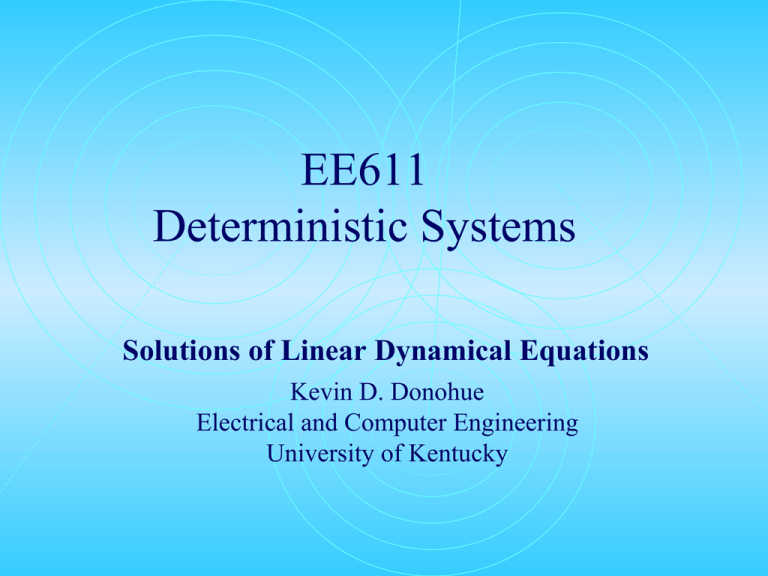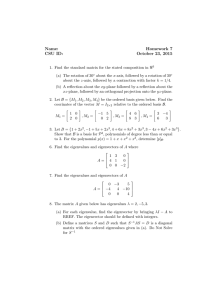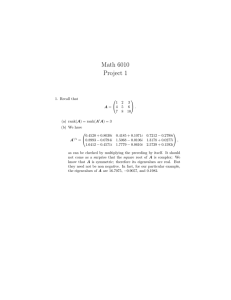EE611 Deterministic Systems Solutions of Linear Dynamical Equations
advertisement

EE611
Deterministic Systems
Solutions of Linear Dynamical Equations
Kevin D. Donohue
Electrical and Computer Engineering
University of Kentucky
Time-Domain Solution of LTI State Equation
Given a LTI state-space equation:
ẋ t=A x tB ut
y t =C x tD ut
Show the solution for the state can be expressed as:
t
x t=expA t x 0∫ exp A t− B ud
0
and output as:
t
y t =C expA t x 0C ∫ exp A t− B u d D u t
0
Laplace-Domain Solution of LTI State Equation
Given a LTI state-space equation:
ẋ t=A x tB ut
y t =C x tD ut
Show the solution for the Laplace transform of the state
can be expressed as:
−1
−1
x s = s I−A [ x 0 ] s I−A B [ u s ]
and output as:
y s =C s I−A [ x 0 ] C s I−A BD [ u s ]
−1
−1
Examples
Find the unit step response to the following state-space equation
for t ≥ 0:
−2 3
0
ẋ=
x ut
0 −1
1
[
] []
y=[ 1 0 ] x
Show:
[
3 5
− exp−2 t
xt= 2 2
1
[ ]
x 0= −1
1
with
]
1
y t = 3−5exp−2 t
2
for
t≥0
for
t≥0
Discretization
Consider sampling the inputs and outputs of a state-space
equation with sampling interval T = 1/fs where fs is the
sampling frequency.
ẋ t=A x tB ut
y t =C x tD ut
Show that the corresponding discrete system can be represented
by:
x [k 1]=Ad x [k ]B d u[k ]
y [ k ]=Cd x [k ]Dd u[k ]
where k corresponds to t=kT and:
A d =expA T
Bd =
T
∫ expA d
0
B
Cd =C
Dd =D
Solution of Discrete LTI State Equation
Given a discrete-time state equation:
x [k 1]=A x[ k ]B u[ k ]
y [ k ]=C x [k ]D u[k ]
Show that the solution can be written as:
k−1
k
x [k ]=A x[0] ∑ A
k −1−m
B u[m]
m=0
k−1
k
y [ k ]=C A x[0] ∑ A
m=0
k−1−m
B u[m] D u[ k ]
Examples
Find the solution to the following discrete-time state equation for
k ≥ 0 and no input (zero input response):
[ ]
1
x[ k 1]= 2
1
−
3
show:
[
x[ k ]=
1
3 x[ k ] 1 u t
1
0
2
with
k
−
−
13
[]
6
k
sin .588 k
13
cos.588 k
6
]
for
[ ]
x [0]= 0
−1
k≥0
Equivalence
Given an n by n nonsingular matrix P that represents a change of
basis x =P x then the following systems are (algebraically)
equivalent:
x t B
ut
̇x t= A
x t D
ut
y t = C
ẋ t=A x tB ut
y t =C x tD ut
where
=P A P−1
A
=P B
B
=C P−1
C
=D
D
Zero-State Equivalence
State equations are zero-state equivalent iff they have the same
transfer matrix:
−1
−1
s I− A
B
D
C s I−A BD=C
It can be shown that 2 LTI state equations
{ A , B ,C , D}
,B
,D
,C
}
{A
are zero-state equivalent iff D= D
m
m
for m=0,1,2,...
C A B= C A B
Modal Form Complex Eigenvalues
Consider the following Jordan form
[
1
0
0
0
0
0 1 j 1
0
0
0
0
0
1 − j 1
0
0
0
0
0
2 j 2
0
0
0
0
0
2− j 2
]
A similarity transformation can be preformed to convert it to all
real values in the following modal form:
[
1 0
0
0
0
0 1 1 0
0
0 −1 1 0
0
0
0
0
2 2
0
0
0 −2 2
]
Modal Form Complex Eigenvalues
Given a matrix A with complex eigenvalues, it can be
can be
diagonalized with eigenvector Q, and then a matrix Q
found to put in modal form.
A diagonal Q=A
P
P A Q=A diagonal
modal
P A Q Q=A
P
modal
Example: Find similarity transformation to perform the form
change:
[
Show
1 j 1
0
0
1− j 1
[
1 −j
P=
1 j
]
]
[
]
[
]
1 1
−1 1
1 1 1
Q=
2 j −j
Modal Form Complex Eigenvalues
In general for any A with complex eigenvalues, Q Q
found directly from the eigenvalues associated with Q
can be
Q=[q 1 , q 2 , ..., q n ]
where q1 and q2 are associated with a complex conjugate
eigenvalues (note the eigenvector will also be complex
conjugate pairs as well). Then
Q Q=[Real
q 1 , Imag q 2 , ..., qn ]
Lecture Note Homework U5.1
Find the solution y[k] for:
[
x [k 1]=
]
[]
0.5 −0.25
1
x[ k ] u[ k ]
0
0.1
2
y [ k ]= [ 1 0 ] x [k ]
given the system is relaxed at k = 0 and input is the unit impulse.






